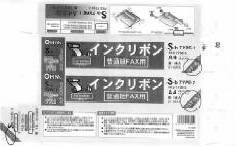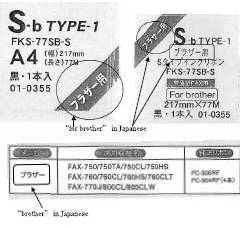Court Case Review (Trademark): Brother Industries Case
地域:日本
業務分野:商標
カテゴリー:判例
『Yuasa and Hara Intellectual Property News』No.15 所収、
2004年
神蔵 初夏子
Court Case Review (Trademark): Brother Industries Case
In the Brother Industries case, HEI-15 (Wa) 29488, the Tokyo District court held that, in a case where a trademark is used on packages of substitutable products, that are designed to be used in conjunction with office equipment manufactured by an owner of the same trademark, and where the manufacturer of substitutable products are not the owner of the trademark used on the products, there is no trademark infringement so far as the trademark is used to indicate that substitutable products could be used in conjunction with the trademark owner’s equipment.
The plaintiff in this case, Brother Industries, the owner of trademark registrations for “brother” and “brother in Katakana” in “Class 9- electrical communication apparatus and instruments” and “Class 16- inked ribbons and typewriter ribbons”, sought an injunction against the defendant’s use of the terms “for brother”, and variations thereon, on the packages of inked ribbons and typewriter ribbons.
The facts
The defendant, OHM Electric Inc, a manufacturer of inked ribbons, used the term “for brother” on the packages of inked ribbons. The term “for brother” appears both in gothic characters and in outline type fonts, the fonts being smaller than those of other words which appear on the packages. Further, on the sides of the packages, the term “for new type of brother (in Japanese)” appears. On another side of the packages, a list showing compatible equipment appears. In this list, the word “brother” (without the word “for”) appears.
The issues of the trial
The issues of this trial are whether use of the trademark by the defendant constitutes infringement.
The assertion of the plaintiff
On the packages of the defendant’s goods, a mark “brother” is used in conjunction with a preposition “for”, both in English and in Japanese. The phrase “for brother” and its Japanese counterpart could generally be considered to indicate that the inked ribbons are compatible with the facsimiles manufactured by the plaintiff, Brother Industries. If and when the plaintiff could produce similar goods, they would use similar descriptions on the packages. This would clearly constitute usage of the Brother Industries’ trademark. Accordingly, the defendant’s use of these descriptions should also be regarded as use of the plaintiff’s trademark.
Further, the term “for brother” in English and in Japanese appear in 8 or 9 places on the packages. In contrast, the name of the defendant “OHM Electric Inc.” appears in only one place on the packages. The majority of users of facsimiles are aged persons who are not familiar with English. If they see the companies name “OHM Electric Inc.”, they will not be able to understand its meaning or its pronunciation, “o: – mu”. As the defendant is not well known, they would not recognize “OHM Electric Inc.” to be the name of the company which manufactured the goods. On the contrary, the term “brother” is a familiar English word in Japan. Therefore, use of the description “for brother” and its Japanese counterpart is likely to lead consumers to believe that Brother Industries manufactured the products. The plaintiff asserted that they actually received some inquiries from consumers about the defendant’s inked ribbons, and that this fact proved that there was confusion as to the source of the goods.
Consequently, the descriptions used on the packages of the defendant’s goods constitute the use as trademarks representing the origin of the defendant’s goods.
The assertion of the defendant
It is clear that the descriptions “for brother” and the corresponding Japanese description are used to show that these products are compatible with facsimiles manufactured by the plaintiff, Brother Industries. Therefore, nobody would consider that the descriptions imply that Brother Industries makes and sells the inked ribbons. There are many types of facsimile machines, using inked ribbons of different designs, and these descriptions are absolutely necessary to enable consumers to select an inked ribbon which is compatible with their own equipment. If these descriptions were considered to be trademark infringements, only the equipment manufacturer would be permitted to supply compatible accessories. Such a conclusion would be completely impractical and unreasonable.
The decision of the court;
The nature of the defendant’s product: The defendant’s goods are expendable or substitutable and are not reusable. That is to say, when an inked ribbon for inked ribbon facsimile machines is used up, it is discarded and a new one will be replaced. It is common to indicate the name of the compatible machines on the packages of the goods to prevent customers from purchasing wrong goods. When consumers purchase expendable goods, they refer to these descriptions to confirm compatibility. Additionally, it is widely known that companies manufacturing expendable goods are not always the same as companies manufacturing compatible equipment. Accordingly, consumers would recognize that the description “for brother” and the corresponding Japanese description on the packages of the inked ribbons, are used to inform consumers that this inked ribbon is compatible with facsimiles manufactured by Brother Industries.
Accordingly, it is indispensable to provide the information that the subject inked ribbons are used for the facsimile manufactured by the plaintiff, to ensure that consumers do not purchase the wrong type of inked ribbons.
Further, on the packages, a description of the goods “inked ribbons” and a comment “for normal paper-type facsimile” clearly appear. Also, as the word “for” is a basic word taught in junior high schools in Japan, most consumers would be able to understand the meaning of the description “for brother”; namely, that the product is compatible with facsimiles manufactured by Brother Industries.
Consequently, the descriptions used by the defendant are not recognized to constitute usage as trademarks, or to represent the source of the goods.
Postscript
After that, we heard that the plaintiff appealed to the Tokyo High court. Since it has just been appealed, the result has not come out yet. We think that the decision would be upheld, as the judgement of the district court appeared to be rational. Well, what a result would be brought?
執筆者
商標・意匠部アソシエイト 弁理士
神蔵 初夏子 かみくら はなこ
[業務分野]
意匠 商標
商標分野の他の法律情報
お電話でのお問合せ
03-3270-6641(代表)



